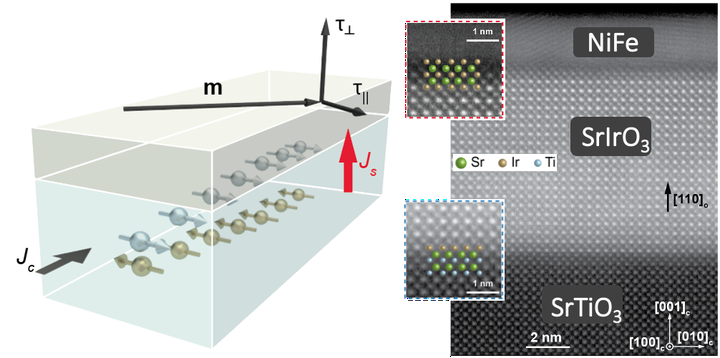Efficient spin-to-charge conversion for spintronics
 TEM images
TEM images
The recent exciting discoveries in the field of spintronics include the creating or detecting of spin currents in non-magnetic materials or interfaces with strong spin-orbit coupling, which originates from bulk spin-Hall or interfacial Rashba effects. Importantly, the spin-orbit interaction induced spin polarized currents can interact with magnetic moment and exert torque on the adjacent magnetic materials. Such torque, also known as spin-orbit torque, can efficiently switch the magnetization, and provide means of controlling topological solitons in chiral spin textures (i.e. skyrmions). Materials with high-efficient intrinsic spin-charge conversion is the key to enable those interesting applications.
Strongly correlated materials, which harbor quantum many-body system, can be a fertile playground for both fundamental understanding of spin-orbit effects, since the interplay between electron correlation and spin-orbit interaction can give rise to non-trivial electronic band topologies and nonzero Berry curvature. However, such materials have not been fully exploited in the fundamental studies or applications of spintronics so far. We have shown that a perovskite correlated semimetal SrIrO3 can indeed generate pure spin current via the spin-Hall effect at room temperature more efficiently than that reported for elemental heavy metals. The efficiency can also be strongly modified by epitaxially tailoring the SrIrO3 lattice symmetry, thus suggesting a path toward engineering efficient room-temperature spintronics.
Related publications:
- Anisotropic spin-orbit torque generation in epitaxial SrIrO3 by symmetry design, PNAS 116, 16186-16191, (2019)
- A strain-mediated magnetoelectric-spin-torque hybrid structure, Advanced Functional Materials 29, 1806371, (2019)
- Spontaneous Hall Effect enhanced by local Ir moments in epitaxial Pr2Ir2O7 thin films, Physical Review B 101, 104405 , (2020)